9.1 Reinforcement Design Moments in a Finite Element Slab
Subjects Covered
- Creating new sub models
- Moving elements from one sub model to another
- Reinforcement sets
- Moment triads
- Design Moments
Outline
Consider the finite element slab as described and modelled in example 6.5 and loaded in example 7.4.
It is required to establish the design moments; hogging and sagging; main & secondary, in a given reinforcement direction in various parts of the slab due to dead load only. The design moments will be based on the Wood Armer equations. The idealized reinforcement directions in the various components of the slab are as shown below.

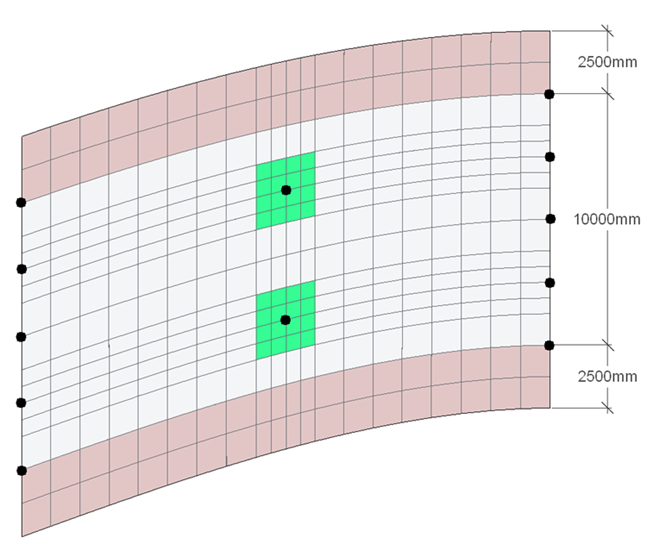
For hogging, the main reinforcement is parallel to a line joining the deck centre points at each end.
Procedure
- Start the program and use the Home Open button to open the file “My EU Example 7_4.sst” created in section 7.4. Close the Project Overview with the ✓ Done button.
- Use the Date | Titles menu option to change the Project Title to “Curved FE Slab – Reinforcement Moments” and the sub title to “Example 9.1”.
- Change the Job Number: to “9.1” and put your initials in the Calculations by: field before closing the form with ✓ OK.
- Click on Add Model | Refined Model in the toolbar at the top of the Structure Definition pane.
New Design Line
In the Structure Definition toolbar click on
 and select “Design Line” from the dropdown list.
and select “Design Line” from the dropdown list.Set the Snap: mode in the graphics toolbar to “Intersection” and then click on the node at the centre of each end of the structure. (You may need to zoom in on the graphics window to do this).
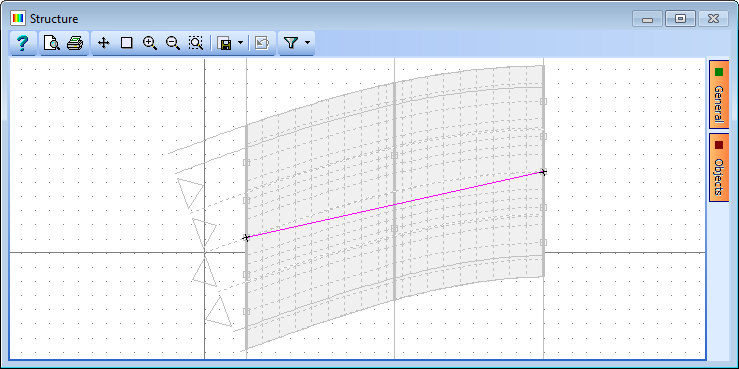
Set Name to “Secant of CL” and then close the Define Design Line form with the ✓ OK button.
New Sub Models
For different reinforcement calculations to be carried out independently for different slab thicknesses it is necessary to have a different sub-model for each slab thickness. It is therefore necessary to create two new sub models (in the same plane and with the same origin as the existing sub model) and move the appropriate elements from one to another.
- Click on “Structure” at the top of the navigation window. Click on
 in the toolbar of the navigation window and select “2D Sub model (GCS, Z=0) from the dropdown list.
in the toolbar of the navigation window and select “2D Sub model (GCS, Z=0) from the dropdown list. - Rename this sub-model to “300 slab” by right mouse clicking on the submodel entry in the navigation window and choosing “Rename” from the options.
Moving Elements between Sub Models
Within the “2D Sub Model: 2D Model A” sub model, in the navigation tree, click on Sub Model Members.
To place the 300 thick elements into the appropriate sub model we first need to select and then move them.
In the graphics window toolbar click on the filter button and then in the Member Selection Filter form click on De-select All. Then set Select By: to “Structure Property”.
Move the 300mm property into the Selected Groups: by selecting it then clicking on the “>” button. Close the filter form with the ✓ OK button.
Select all the displayed elements in the graphics window by windowing around the whole structure.
In the Define Sub Model Members table click on Move to Sub Model... in Member Tasks then select the 300 slab sub model before closing the Sub Models form with the ✓ OK button.
Close the Define Sub Model Members form with the ✓ OK button.
Repeat steps 7 to 15 for the 700 slab. You will need to click on “Structure” at the top of the tree so that the
 button is displayed again. After doing this, Rename the “2D Model A” sub model as “500 slab”.
button is displayed again. After doing this, Rename the “2D Model A” sub model as “500 slab”.Finally, use the drop down arrow next to the filter button in the graphics window to turn off the filter (Select All).
Analysis
The reinforcement moment calculations are principally post processing of load case results, so the analysis of the already defined load cases can now be carried out.
Use the menu item Calculate | Analyse to perform the analysis.
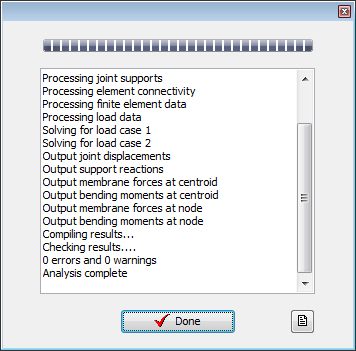
Close the Analysis form with the ✓ Done button once the analysis is complete.
Defining the Reinforcement Sets
One or more reinforcement sets now need to be defined for each sub model.
In the navigation window, select the 500mm Slab sub model and then right mouse click to select Add | Reinforcement Set.
In the Define Reinforcement Set form change the Name: to “500 sag”, click on the curved design line in the graphics window, click only “Sagging” in the Face tick box and lastly tick the “Design” option in the Results for: tick box.
The reinforcement direction can be seen in the graphics display.
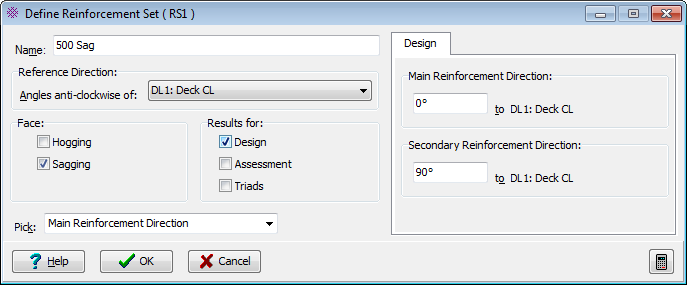
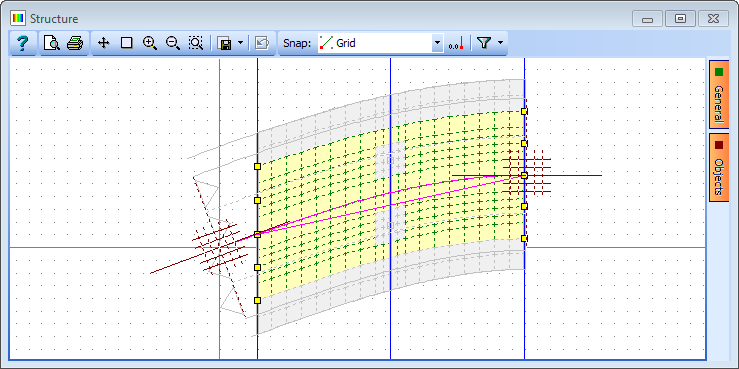
Close the Define Reinforcement Set form with the ✓ OK button.
Repeat steps 20 to 21 to create a second reinforcement set in the same sub model. This time it is named “500 Hog”, the straight design line is selected and Hogging and Design are both ticked.
To skew the secondary reinforcement so that it is parallel to the lines of the supports change Pick: to “Secondary Reinforcement Direction” and then click on any two nodes or grid points on the right hand span end line.
Close the Define Reinforcement Set form with the ✓ OK button.
There will then be two reinforcement sets in the 500 Slab Sub Model.
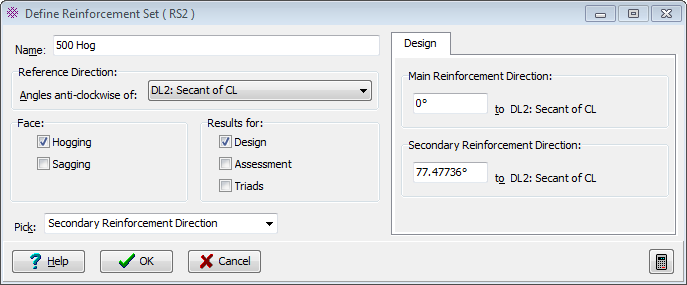
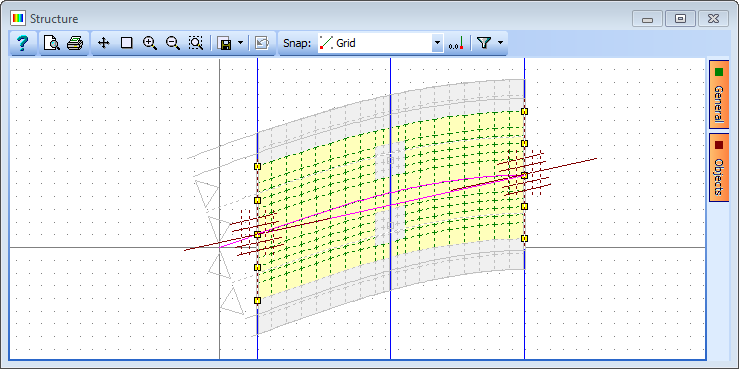
Repeat steps 21 to 25 for the 300 slab sub model with exactly the same reinforcement sets data as the 500 Slab, but of course use appropriate names.
Repeat steps 21 to 21 for the 700 slab sub model but this time both Hogging and Sagging reinforcement are in the same direction and are both ticked. The reinforcement direction data for this case is the same as for the “500 Hog” set. Set the name for this set to “700 Hog & Sag”.
Results
Use the main menu File | Results to open the Results Viewer. Set the view to be combined graphic and table, as shown below, by using the menu items View | Set Default Layout | Graphic Above Table.
Adjust window size to suit by holding the left mouse button down on the dividing line between the graphics and table and dragging to a new position.
In the dark blue area at the top of the window (Results Controller) set Results For: to “Reinforcement Moments”, Name: to “L1: Concrete Dead Loads” and set: to “RS1: 500 Sag”.
In the graphics toolbar, the Results For: field should be set to “Design – Sagging Main”.
Change the viewing direction to plan by clicking on the Graphics toolbar icon
 and click on the “Auto Redraw” button if the graphics are not automatically updated.
and click on the “Auto Redraw” button if the graphics are not automatically updated.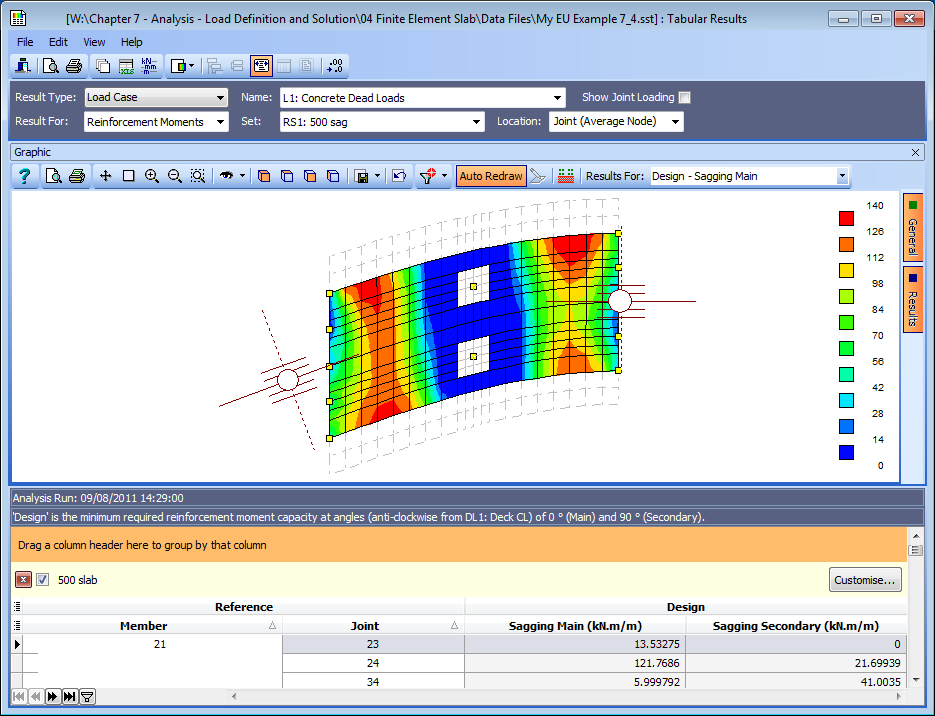
All the other reinforcement sets and components can be displayed and printed in a similar way.
Close the results viewer.
Use the main menu File | Save As to save the data file with a name of “My EU Example 9_1.sst”.
Close the program.
Summary
This example illustrates that if reinforcement moments are to be created for different components of a structure, then each component should be in a separate sub model, and that results can be obtained separately for each component. This will mean that discontinuities, occurring at the boundaries of different thickness slabs, are correctly allowed for.
Although in this example we have only considered one load case, the results for compilations and envelopes are also available.
It should be pointed out that the results for compilations are not obtained by simply summing the reinforcement moment results for each constituent load case. This would be incorrect as the Wood Armer equations are not a linear set of equations. They are calculated by summing the component moment triad results and then performing the Wood Armer calculations on the resultant moment triad. In this example we have only considered the calculation of Design Moment. It should be noted that there are an equivalent set of equations (Denton Burgoyne) which can be used for assessing the adequacy of a known set of reinforcement. This will be covered in a separate example.
